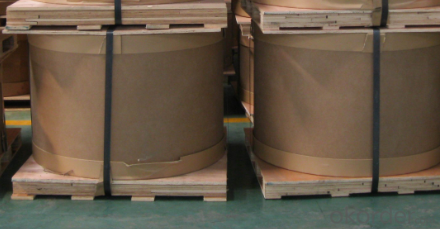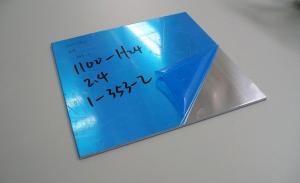Aluminium Sheet And Aluminum Slabs Stocks With Best Price
- Loading Port:
- Shanghai
- Payment Terms:
- TT or LC
- Min Order Qty:
- 7 m.t.
- Supply Capability:
- 4000 m.t./month
OKorder Service Pledge
OKorder Financial Service
You Might Also Like
1.Structure of Product Description
1010, 1050,1060,1100, 2024, 3003, 3005, 3105, 5052,5754,5083,6061,6063,8011, etc.
The temper is include H14, H22, H24, H44,H112,H114,etc.
2. Main features of the product
a.Competitive price
b.Frist-Class Service.
c. Shortest service.
3. Image.

4. Product detailed sizes:
1000mm*2000mm, 1219mm*2438mm,1220mm*2440mm, 1250mm*2500mm,1500mm*3000mm, etc.
5. FAQ:
What is the quality standard?
---Usually our standard is GB3880-2006 or others.
What is the width range?
---It is from 1000mm to 2500mm, etc.
How many tons did you export in one year?
---Normally it is around 9000 tons totally.
Where is your client from?
---Normally it is from Japan, USA, ENGLISH, SINGAPORE, ETC.
What is your mainly products?
---Normally they are aluminum sheet, checkered sheet, mirror finish aluminium sheet, aluminum casting coil, etc.
- Q:How do i prepare the aluminium sheet to paint with oils on it?Do I have to buy special aluminium or any kind will work?
- Prep and clean with vinegar
- Q:How does the surface roughness affect the friction properties of aluminum sheet?
- The friction properties of an aluminum sheet are significantly affected by its surface roughness. When the surface is rough, there are more microscopic peaks and valleys, which can enhance the frictional forces between the sheet and the contacting surfaces. Generally, an increase in surface roughness results in a higher friction coefficient. This occurs because the roughness increases the effective contact area between the aluminum sheet and the opposing surface, leading to more interlocking and adhesion between the two surfaces. Consequently, the resistance to relative motion, or friction, is heightened. Moreover, a rough surface can trap lubricants or contaminants, reducing lubrication efficiency and increasing friction. The roughness of the aluminum sheet also influences the formation and retention of a lubricating film, further impacting the friction properties. It is important to acknowledge that the type of roughness, such as its amplitude, wavelength, and orientation, can also affect the friction properties. For instance, certain surface textures, like grooves or patterns, may facilitate lubricant retention and reduce friction, even with increased roughness. In summary, the friction properties of an aluminum sheet are significantly determined by its surface roughness. A rough surface increases the contact area and adhesion between the sheet and opposing surface, resulting in higher friction coefficients. However, the specific characteristics of the roughness and the presence of lubricants or contaminants can further influence the friction behavior.
- Q:What are the different fabrication methods used for aluminum sheets?
- Aluminum sheets undergo various fabrication methods, each presenting its own advantages and applications. Rolling, extrusion, casting, and stamping are among the most commonly employed techniques. Rolling, the most prevalent method, entails passing the aluminum through a series of rollers to reduce thickness and form a flat sheet. This approach allows for precise control over sheet thickness and shape, rendering it suitable for an array of applications, from packaging to building materials. Another well-received method is extrusion, where heated aluminum is pushed through a die to create a specific shape or profile. This technique is commonly employed to manufacture intricate shapes like tubes, rods, and channels. Extruded aluminum sheets exhibit high strength and durability, making them appropriate for structural applications in construction and automotive industries. Casting involves pouring molten aluminum into a mold, allowing it to solidify. This method is frequently used for producing intricate shapes that are challenging to achieve through other means. Cast aluminum sheets can boast unique textures and designs, making them popular for decorative purposes. Stamping utilizes a press to shape the aluminum sheet by exerting pressure and forming it into the desired shape. This technique is commonly utilized for creating precise, small parts such as brackets, connectors, and electrical components. Stamped aluminum sheets offer exceptional dimensional accuracy and can be produced in large quantities at a relatively low cost. Additionally, other fabrication techniques such as welding, bending, and laser cutting can be employed to further process aluminum sheets and craft custom shapes and designs. In conclusion, the choice of fabrication method for aluminum sheets relies on the desired application, required properties, and complexity of the desired shape. Each method possesses unique advantages and capabilities, enabling a broad range of possibilities in aluminum sheet fabrication.
- Q:How do aluminum sheets perform in terms of impact resistance?
- Aluminum sheets are known for their excellent impact resistance properties. Due to their high strength-to-weight ratio, they can withstand significant impacts without deforming or breaking easily. Additionally, aluminum has inherent toughness and flexibility, which allows it to absorb and distribute the force of an impact, minimizing the risk of damage. This makes aluminum sheets a preferred choice for applications requiring durability and resistance to impact, such as in the automotive, aerospace, and construction industries.
- Q:has aluminum sheet reacted with concentrated sulfuric acid?
- it can be regarded as no reaction, concentrated sulfuric acid will make aluminum's surface inactivation,and produce a layer of dense aluminium oxide film which will prevent further reaction.
- Q:Are aluminum sheets suitable for signage and advertising?
- Yes, aluminum sheets are highly suitable for signage and advertising purposes. Aluminum is a durable and lightweight material, making it ideal for creating signs that can withstand outdoor weather conditions and transportation. Its resistance to rust and corrosion ensures that the signs will maintain their appearance and functionality over time. Aluminum sheets can be easily cut and shaped into various sizes and designs, making them versatile for different advertising needs. Additionally, aluminum's smooth surface allows for high-quality printing and graphics, providing excellent visibility and readability for signage. Overall, with its durability, versatility, and aesthetic appeal, aluminum sheets are a practical and effective choice for signage and advertising.
- Q:What are the different methods of surface protection for outdoor aluminum sheet?
- To ensure the durability and longevity of outdoor aluminum sheets, there are several methods available for surface protection. These methods offer varying advantages and limitations, and the choice should be based on factors such as durability, appearance, cost, and maintenance requirements. One common method is anodizing, which creates a protective oxide layer on the surface. This increases resistance to corrosion, abrasion, and UV rays, while also providing a range of colors and finishes. Another option is powder coating, where a dry powder is applied to the aluminum sheet and baked to create a hard, protective coating. This method offers excellent resistance to weathering, corrosion, and chemicals, and is available in various colors and finishes. Paint coating is another effective method, creating a barrier between the aluminum surface and the environment to prevent corrosion while enhancing aesthetics. It is important to use high-quality paint specifically designed for aluminum to ensure proper adhesion and durability. For those looking to protect the natural appearance of aluminum, clear coating is an option. It provides a layer of protection against corrosion, oxidation, and UV rays and is often applied after anodizing or polishing. Laminating involves adhering a protective film or sheet onto the aluminum surface, offering excellent resistance to scratches, abrasion, and UV rays. This method is commonly used in applications with heavy wear and tear. Chemical conversion coatings, such as chromate conversion coating or phosphating, can be used to improve the corrosion resistance of aluminum sheets. These coatings chemically react with the surface to create a protective layer that inhibits corrosion. When choosing a method of surface protection, it is crucial to consider specific requirements and environmental conditions. Each method has its own advantages and limitations, so careful consideration is needed to ensure the best choice for the aluminum sheet's needs.
- Q:What are the advantages of using aluminum sheets in automotive applications?
- There are several advantages of using aluminum sheets in automotive applications. Firstly, aluminum is lightweight, which helps improve fuel efficiency and overall vehicle performance. Secondly, aluminum has high strength-to-weight ratio, making it durable and resistant to corrosion. This ensures a longer lifespan for automotive components made from aluminum sheets. Additionally, aluminum is easily recyclable, making it an environmentally friendly choice. Lastly, aluminum sheets can be easily formed and molded into complex shapes, allowing for greater design flexibility in automotive manufacturing.
- Q:Can aluminum sheets be used for cookware?
- Yes, aluminum sheets can be used for cookware. Aluminum is a popular material for cookware due to its excellent heat conductivity and lightweight properties. Aluminum sheets are often used as the base or core material in the construction of cookware, such as pots, pans, and baking sheets. They are typically coated with a nonstick or ceramic layer for added durability and ease of use. However, it is important to note that pure aluminum is reactive with certain acidic or alkaline foods, which can cause a metallic taste or discoloration. To prevent this, most aluminum cookware is anodized or coated to create a barrier between the food and the aluminum surface. Overall, aluminum sheets are a versatile and commonly used material for cookware in both professional and home kitchens.
- Q:Can 101 aluminum sheets be CNC machined?
- Yes, 101 aluminum sheets can be CNC machined. CNC machining is a versatile and precise manufacturing process that is commonly used for aluminum materials. The process involves the use of computer-controlled machines to remove material from the aluminum sheets, allowing for intricate and accurate cuts, holes, and shapes to be created. The specific alloy designation of 101 aluminum sheets does not pose any limitations on their CNC machinability. However, it is important to consider factors such as cutting parameters, tool selection, and feed rates to ensure optimal results when machining aluminum sheets.
1. Manufacturer Overview |
|
|---|---|
| Location | |
| Year Established | |
| Annual Output Value | |
| Main Markets | |
| Company Certifications | |
2. Manufacturer Certificates |
|
|---|---|
| a) Certification Name | |
| Range | |
| Reference | |
| Validity Period | |
3. Manufacturer Capability |
|
|---|---|
| a)Trade Capacity | |
| Nearest Port | |
| Export Percentage | |
| No.of Employees in Trade Department | |
| Language Spoken: | |
| b)Factory Information | |
| Factory Size: | |
| No. of Production Lines | |
| Contract Manufacturing | |
| Product Price Range | |
Send your message to us
Aluminium Sheet And Aluminum Slabs Stocks With Best Price
- Loading Port:
- Shanghai
- Payment Terms:
- TT or LC
- Min Order Qty:
- 7 m.t.
- Supply Capability:
- 4000 m.t./month
OKorder Service Pledge
OKorder Financial Service
Similar products
New products
Hot products
Hot Searches
Related keywords





























